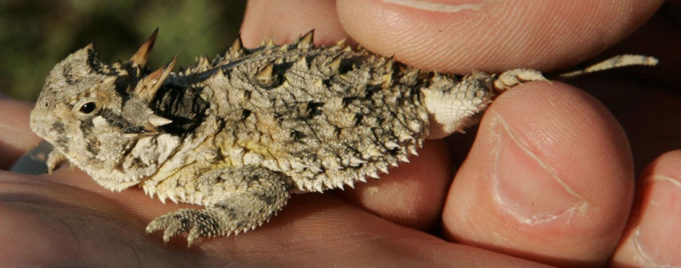A friend’s 3-year-old boy is enthralled with toy dinosaurs and carries one with him wherever he goes. Imagine what the tyke would think if he could walk into his backyard in Fort Worth and find a real, live tiny Triceratops to play with.
He never will, but his kids might. Or maybe his grandkids.
Since 2005, the Fort Worth Zoo has been a leader among a group of organizations trying to re-populate Texas with horny toads.
I was lucky enough to grow up in 1960s-era Fort Worth, when the critters were still easy to find. Technically, they were lizards, but everyone around here called them horny toads. Or if you attended TCU, you might have referred to them as horned frogs after the school mascot.
The palm-sized reptile was covered in gnarly-looking spikes with two horns protruding from its head. The lizards looked incredibly fierce, but you could pick them up and play with them without being hurt. They puffed up their bodies to look bigger and meaner, which was fun to watch. You could lay them on their backs and stroke their bellies and lull them into a deep reptilian slumber. Supposedly, they could spit blood from their eyes when threatened, although I never saw one do it, and I handled quite a few. I’ve spoken with other locals, however, who insist they saw the blood spurts.
In the fall, the lizards would burrow into the ground to hibernate and reappear in spring, hungry, roaming, and hunting their favorite treat –– red ants (another thing you don’t see anymore). The horny toad is our official state reptile, although it’s pretty much extinct in all but portions of far West Texas. Their fascinating appearance worked against them – they looked so cool, they became harvested for the pet trade. Then non-native fire ants gained footage and began feasting on horny toad eggs and babies, vastly reducing their numbers. Throw in the advent of modern insecticides, and horny toads dwindled in number by the 1970s.
In 1977, the Texas Parks and Wildlife Department added the horny toad to the threatened species list, but little had been done to save the lizards until 2005, when the Fort Worth Zoo initiated a program to breed them and release the babies onto private property in West Texas. Zoo officials work with TCU, Texas Parks and Wildlife, and other organizations and researchers to breed and reintroduce the horny toad.
Someone trying to raise awareness in a more artistic way is local songwriter James Michael Taylor. In the 1950s, he grew up near the Mojave Desert in California where horny toads were abundant. “There is nothing cooler,” he said. “A baby horny toad is about a half-inch wide and comes out of its egg a fully developed creature. They were part of the fascination of my childhood. They are like little dinosaurs.”
In the early 2000s, he wrote and recorded “Lament for Horny Toad,” an environmental-themed Americana song that describes how, as a child, he left lizards in a glass jar in the sun by mistake. “I went back and found them dead, which was a trauma from my childhood, like a warning of something to never, ever do again,” he said.
Twenty years ago, he pulled into a truck stop in Amarillo and saw little horny toad hatpins for sale. He bought one for his hat and several others for friends. He would stop and buy more whenever he was passing through Amarillo until one day there were none left. An employee gave him the name of the company that sold the jewelry, and Taylor ordered a bulk amount. He’s continued to purchase bulk orders for the past 15 years and hand out horny toad hatpins.
“I started giving everybody those to raise awareness of the fate of horny toads,” he said. “They are being decimated. I’ve literally given hundreds of those things away.”
He gave me a hatpin years ago, and it’s still displayed proudly on my felt cowboy hat. I’m a sucker for horny toads, too. If you played with them as a child, you probably feel the same.
In the fall of 2018, the Fort Worth Zoo released 140 horny toad hatchlings into the wild at the Mason Mountain Wildlife Management Area near Llano. Most were hatched at Fort Worth Zoo, although the Dallas and San Antonio Zoos contributed as well. Researchers with Parks and Wildlife studied the lizards as they prepared for hibernation. The group has helped reintroduce more than 400 lizards into the wild at various ages, then tracked and studied them to determine best possible reintroduction methods.
Civilians have also joined in the effort, many of them participating in the Parks and Wildlife’s Horned Lizard Watch program. Residents around the state adopt geographic sites compatible with horny toads and observe and report during their breeding periods between May and September. The information helps researchers understand the lizard population, where they live, and how they coexist with other wildlife, especially ants. The ultimate goal is to develop land management practices that benefit the horny toads.
Or as Taylor sings on his song: “Maybe we could save the horny toad / But that would require we save the Earth.”













Thanks for this remembrance of simpler times and serene childhood summer vacations with the beloved horny toads. Also a favorite–blue tail lizards–so cool.
Growing up on South Side FW in the late ’60s, we often had Horney Toads in the yard. And yes, they might have not squatted blood out of their eyes when molested, but they did have a drip of blood if you messed with them enough.
Nicely composed piece about a unique and important creature. Any idea what is being done to mitigate the fire ants as a devastating factor? Thanks